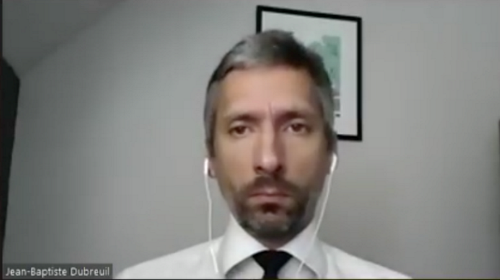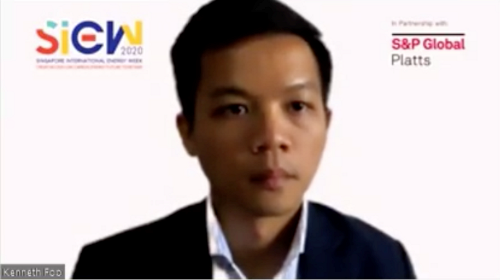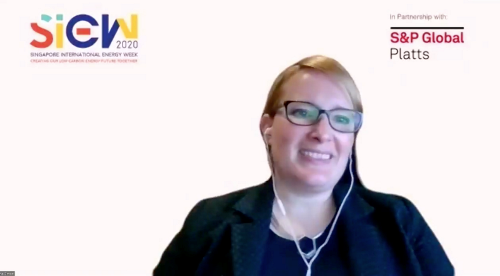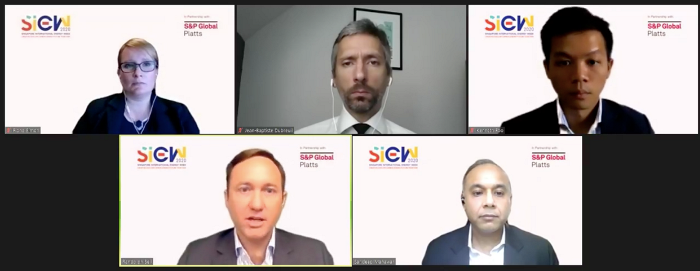New developments in hydrogen and LNG are at the heart of the conversations around the growing momentum to decarbonise energy systems and adopt cleaner alternatives to fuels such as coal.
On 22 July, SIEW and S&P Global Platts co-hosted the second SIEW Energy Insights Webinar to put the spotlight on the role of LNG and hydrogen in energy transition. S&P Global Platts is the organiser of SIEW partner event, LNG and Hydrogen Gas Markets Asia.
The webinar featured presentations by Jean-Baptiste Dubreuil, Senior Gas Analyst from the International Energy Agency; Kenneth Foo, Managing Editor, Asia LNG at S&P Global Platts; and Dr Fiona Simon, Chief Executive Officer of the Australian Hydrogen Council. The speakers were later joined by Randolph Bell, Director of Global Energy Center at Atlantic Council, for an engaging panel discussion moderated by Sandeep Mahawar, Senior Vice President, Commercial & Business Development at the Singapore LNG Corporation.
Gas outlook: Cloudy with a chance of recovery in 2021
Mr Dubreuil opened with the latest research finding from the IEA’s annual gas market outlook. He noted that the global gas markets are in the midst of an unprecedented demand shock in 2020 due to COVID-19 disruptions. Reduced heating demand from a mild winter and a slowdown in industrial activities are main contributing factors to the demand drop.

“We expect to see a 4% drop in global gas consumption in 2020, which is an unprecedented contraction," Mr Dubreuil said. He added that even with most of the 2020 losses expected to be recovered by 2021, the COVID-19 crisis is likely to have a long-lasting impact.
Following IEA’s presentation, Mr Foo from S&P Global Platts reinforced the view that LNG markets have been hard hit by COVID-19 lockdowns imposed worldwide. He further highlighted that spot LNG prices are at record lows due to weakened demand and increased pressure from oversupply—with the US, Qatar and Australian volumes adding to the supply glut.
“In the longer term, we can expect low oil and gas prices coupled with demand disruptions from COVID-19 to slow LNG liquefaction further with a limited capacity increase," Mr Foo said.

Realising the promise of hydrogen
Dr Simon of the Australian Hydrogen Council shared her perspectives on the game-changing potential of hydrogen. In a poll conducted during the webinar, half of the respondents (49%) believed hydrogen will become an abundant and economic fuel of choice in 10-20 years.

With the country having ambitions to become a major exporter of hydrogen, Dr Simon provided updates on the push behind hydrogen adoption and the implementation of Australia’s National Hydrogen Strategy. She highlighted the benefits of hydrogen as a future fuel: such as its higher energy density, potential for zero greenhouse gas emissions, and versatile use across energy, transport and industrial sectors.
Dr Simon said: “We are seeing a global shift towards a low carbon future, with some countries setting ambitious green targets. This means the cost-benefit analysis of hydrogen is also shifting relative to incumbent sources of energy. But realising the potential of hydrogen for decarbonisation requires infrastructure and investments.”
Cause for cautious optimism
The discussion of hydrogen’s growing potential carried over into the interactive Q&A session, with the panel of experts fielding a variety of questions about emerging LNG market dynamics and the factors underpinning the rise of a robust hydrogen economy.

Discussing the latest clean hydrogen market developments, Mr Bell of the Atlantic Council said that blue hydrogen produced with natural gas (in which the carbon emissions are captured and stored) holds certain market advantages over green hydrogen generated by renewable energy sources. “Blue hydrogen provides an opportunity to scale hydrogen much faster and you can take better advantage of the existing infrastructure that can be used in production," Mr Bell added.
The panellists also weighed in on how the evolving role of LNG in the future energy mix in relation to the rise of hydrogen. Mr Foo of S&P Global Platts pointed out that hydrogen supply and distribution may face barriers such as high production cost and infrastructure requirements—by comparison, the LNG market is currently more mature and is still some “years ahead”.
Mr Foo said: “In terms of the future fuel mix, LNG will continue to play a key role over the next few decades. But for LNG to compete better with other fuels, there is the need for a shift towards market-based pricing for longer-term LNG contracts."
The opportunities for LNG and hydrogen to shape our low carbon energy transition will be a key discussion topic at the upcoming SIEW 2020 on 26-30 October. On the SIEW 2020 theme, ‘Creating Our Low Carbon Energy Future Together’, Mr Dubreuil emphasised the need for energy stakeholders to recognise the importance of building a more resilient and sustainable energy system alongside economic recovery.
Don't miss our upcoming session on clean energy solutions and investments – sign up for the next SIEW Energy Insights Webinar Series.